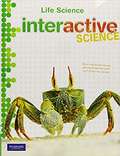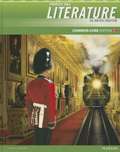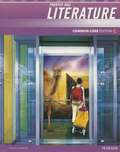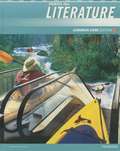- Table View
- List View
More NIMAC books are available at www.nimac.us. If you find your title in the NIMAC and not in Bookshare then please contact us to request it.
Prentice Hall The Reader's Journey, Grade Seven
by Harvey Daniels Grant Wiggins Judith Krimski Design Inc. AartpackNIMAC-sourced textbook
Interactive Science: Physical Science
by Kathryn Thornton Don Buckley Zipporah MillerNIMAC-sourced textbook
Interactive Science: Life Science
by Kathryn Thornton Don Buckley Zipporah MillerThe Interactive Science curriculum for homeschooling is a series of materials you can use to educate your child about science. Spanning from Kindergarten through Grade 8, the program will guide your child through the subject and solidify his or her knowledge. The final installment of Interactive Science, Grade 8 is designed just as carefully as the rest of the homeschool program. All Interactive Science curricula help your child stay engaged in learning by providing materials that include fun labs and exciting activities. Interactive Science: Grade 8 is a dynamic program that allows you to tailor your child's lessons to her or her needs. You can set the pace of your child's education using this curriculum. Furthermore, by using Interactive Science: Grade 8, you'll have all the tools you'll need to ensure each lesson has the right level of challenge for your child and is engaging. The lessons you create using Interactive Science will progress seamlessly through various Grade levels, helping your child develop a solid knowledge of the subject matter. By the time you complete Grade 8, your child should be able to: Interpret and create graphs using data collected during experimentation. Explain basic physics concepts, such as speed, motion and force. Understand and explain the process of natural selection. Explain the relationship between Earth and its solar system. Analyze results of an experiment and determine why they occurred. Explain what chemical reactions are and how they work. You will help your child achieve these and other important goals by using the materials included in Interactive Science: Grade 8. You can get a more detailed look at what is included in this program by visiting the Features and Benefits page. Please note that Pearson creates educational materials for all types of learners. For that reason, when creating a program, we ensure that the material will be accessible to as many students as possible. As such, we create many ancillary products that fit specific situations and meet a variety of needs. While there are many components to each of our overall educational programs, some of these ancillaries do not meet the needs of homeschoolers, others do not make sense in a homeschool environment and some require an expensive technological infrastructure to deploy. The homeschool product configurations, while selected from a larger program, are complete curriculum bundles designed to engage your children and help them thrive while being mindful of your budget. It is important to note that at times there will be resources mentioned throughout our curriculum material descriptions that are not included in your package. However this will not hinder your child's successful completion of the course. Rather, the exclusion of certain materials will make homeschooling more budget-friendly and will ensure your curriculum meets your individual needs.
Interactive Science: Earth Science
by Kathryn Thornton Don Buckley Zipporah MillerThe Interactive Science curriculum for homeschooling is a series of materials you can use to educate your child about science. Spanning from Kindergarten through Grade 8, the program will guide your child through the subject and solidify his or her knowledge. The final installment of Interactive Science, Grade 8 is designed just as carefully as the rest of the homeschool program. All Interactive Science curricula help your child stay engaged in learning by providing materials that include fun labs and exciting activities. Interactive Science: Grade 8 is a dynamic program that allows you to tailor your child's lessons to her or her needs. You can set the pace of your child's education using this curriculum. Furthermore, by using Interactive Science: Grade 8, you'll have all the tools you'll need to ensure each lesson has the right level of challenge for your child and is engaging. The lessons you create using Interactive Science will progress seamlessly through various Grade levels, helping your child develop a solid knowledge of the subject matter. By the time you complete Grade 8, your child should be able to: Interpret and create graphs using data collected during experimentation. Explain basic physics concepts, such as speed, motion and force. Understand and explain the process of natural selection. Explain the relationship between Earth and its solar system. Analyze results of an experiment and determine why they occurred. Explain what chemical reactions are and how they work. You will help your child achieve these and other important goals by using the materials included in Interactive Science: Grade 8. You can get a more detailed look at what is included in this program by visiting the Features and Benefits page. Please note that Pearson creates educational materials for all types of learners. For that reason, when creating a program, we ensure that the material will be accessible to as many students as possible. As such, we create many ancillary products that fit specific situations and meet a variety of needs. While there are many components to each of our overall educational programs, some of these ancillaries do not meet the needs of homeschoolers, others do not make sense in a homeschool environment and some require an expensive technological infrastructure to deploy. The homeschool product configurations, while selected from a larger program, are complete curriculum bundles designed to engage your children and help them thrive while being mindful of your budget. It is important to note that at times there will be resources mentioned throughout our curriculum material descriptions that are not included in your package. However this will not hinder your child's successful completion of the course. Rather, the exclusion of certain materials will make homeschooling more budget-friendly and will ensure your curriculum meets your individual needs.
A Song of War: Readings from Vergil's Aeneid
by Richard A. Lafleur Alexander G. MckayNIMAC-sourced textbook
Realidades 3
by Peggy Palo Boyles Myriam Met Richard S. SayersLos estudiantes de hoy en día esperan hablar un español relevante y real y el ciclo de textos de esta colección permite que ellos se encuentren con un lenguaje real, con actividades reales, cultura real y un aprendizaje del idioma real, con los apoyos de la tecnología que tanto motivan a los alumnos. Arte, fotografías, trabalenguas y otros ítemes son tratados en cada capítulo de manera conjunta, haciendo muy fácil integrar el lenguaje, la cultura y la comunicación en el salón de clases. En el nivel 3 encontrarás los temas: un día inolvidable, cómo te expresas?, cómo mantienes la salud?, cómo te llevas con los demás?, cómo contribuyes a tu comunidad?, cómo será diferente tu futuro?, realidad o fantasía?, un encuentro entre culturas, qué podemos hacer para preservar el medio ambiente? y, derechos y responsabilidades.
Realidades 2
by Peggy Palo Boyles Myriam Met Richard S. Sayers Carol Eubanks WarginRealidades 2 begins with a review chapter that focuses on the basics from first year: talking about yourself, friends, and activities. " A ver si recuerdas" Prior to each theme and some chapters, students will be find this section, the title of which means " Let's see if you remember". It contains a quick summary of vocabulary and grammar from first- year Spanish that connects to the upcoming theme or chapter. At the end of the book, you'll find grammar and vocabulary references from both first- and second- year Spanish.
Realidades 2
by Peggy Palo Boyles Myriam Met Richard S. Sayers Carol Eubanks WarginLos estudiantes de hoy en día esperan hablar un español relevante y real y el ciclo de textos de esta colección permite que ellos se encuentren con un lenguaje real, con actividades reales, cultura real y un aprendizaje del idioma real, con los apoyos de la tecnología que tanto motivan a los alumnos. Arte, fotografías, trabalenguas y otros ítemes son tratados en cada capítulo de manera conjunta, haciendo muy fácil integrar el lenguaje, la cultura y la comunicación en el salón de clases. En el nivel 2 encontrarás los temas: tu día escolar, un evento especial, tú y tu comunidad, recuerdos del pasado, en las noticias, la televisión y el cine, buen provecho, cómo ser un buen turista? y, cómo será el futuro?
Realidades 1
by Peggy Palo Boyles Myriam Met Richard S. Sayers Carol Eubanks WarginNIMAC-sourced textbook
Realidades B
by Peggy Palo Boyles Myriam Met Richard S. Sayers Carol Eubanks WarginLos estudiantes de hoy en día esperan hablar un español relevante y real y el ciclo de textos de esta colección permite que ellos se encuentren con un lenguaje real, con actividades reales, cultura real y un aprendizaje del idioma real, con los apoyos de la tecnología que tanto motivan a los alumnos. Arte, fotografías, trabalenguas y otros ítemes son tratados en cada capítulo de manera conjunta, haciendo muy fácil integrar el lenguaje, la cultura y la comunicación en el salón de clases. En el nivel B encontrarás los temas del 5 al 9: fiesta en familia, la casa, de compras, experiencias y los medios de comunicación. Este volumen, como el resto de la serie, logra balancear la gramática con la comunicación y la tecnología, para motivar a los estudiantes hacia un verdadero aprendizaje.
Realidades A
by Peggy Palo Boyles Myriam Met Richard S. Sayers Carol Eubanks WarginLos estudiantes de hoy en día esperan hablar un español relevante y real y el ciclo de textos de esta colección permite que ellos se encuentren con un lenguaje real, con actividades reales, cultura real y un aprendizaje del idioma real, con los apoyos de la tecnología que tanto motivan a los alumnos. Arte, fotografías, trabalenguas y otros ítemes son tratados en cada capítulo de manera conjunta, haciendo muy fácil integrar el lenguaje, la cultura y la comunicación en el salón de clases. En el nivel A encontrarás los temas del 1 al 4: mis amigos y yo, la escuela, la comida y el tiempo libre. Este volumen, como el resto de la serie, logra balancear la gramática con la comunicación y la tecnología, para motivar a los estudiantes hacia un verdadero aprendizaje.
Virginia Interactive Science, Life Science
by Kathryn Thornton Don Buckley Zipporah MillerNIMAC-sourced textbook
Virginia Interactive Science, Grade 6
by Kathryn Thornton Don Buckley Zipporah MillerNIMAC-sourced textbook
Prentice Hall Mathematics, Course 2, Common Core
by Charles Illingworth McNemarNIMAC-sourced textbook
Prentice Hall Mathematics, Course 1, Common Core
by Randall I. Charles Mark Illingworth Bonnie McnemarNIMAC-sourced textbook
Prentice Hall Literature, Grade 12
by Grant Wiggins Jeff Anderson Arnetha F. BallNIMAC-sourced textbook
Prentice Hall Literature, Grade 12
by Grant Wiggins Jeff Anderson Arnetha F. BallNIMAC-sourced textbook
Prentice Hall Literature, Grade 11
by Grant Wiggins Jeff Anderson Arnetha F. BallNIMAC-sourced textbook
Prentice Hall Literature, Grade 10
by Grant Wiggins Jeff Anderson Arnetha F. BallNIMAC-sourced textbook
Prentice Hall Literature, Grade 9
by Grant Wiggins Jeff Anderson Arnetha F. BallNIMAC-sourced textbook
Prentice Hall Literature, Grade 7
by Grant Wiggins Jeff Anderson Arnetha F. BallNIMAC-sourced textbook
Prentice Hall Literature, Grade 6
by Grant Wiggins Jeff Anderson Arnetha F. BallNIMAC-sourced textbook
Marine Science (Florida Edition): The Dynamic Ocean
by Meghan E. Marrero Glen Schuster Us Satellite LaboratoryEconomics
by Arthur O'Sullivan Steven M. Sheffrin Grant WigginsThis two volume set reprints 28 papers on fiscal and monetary policy interpreted broadly enough to include such issues as the effects of government debt and intergenerational accounting. It emphasizes problems that are not specific to a particular country but are relevant for all developed market economies. Fiscal and Monetary Policy is divided into three parts; the first deals with the problems that are common to both fiscal and monetary policies; the second deals with fiscal policy and the third with monetary policy. Fiscal and Monetary Policy includes important articles on the effects of lags on the feasibility of stabilization policy, time inconsistency, the motivation of monetary and fiscal authorities, the Lucas critique, Ricardian equivalence, the choice of monetary targets, feedback rules, international aspects of monetary policy and the appropriate role of government in the monetary system.




